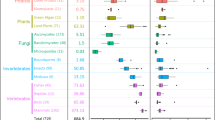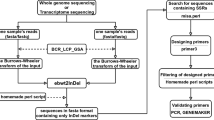Abstract
Microsatellites also known as Simple Sequence Repeats are short tandem repeats of 1–6 nucleotides. These repeats are found in coding as well as non-coding regions of both prokaryotic and eukaryotic genomes and play a significant role in the study of gene regulation, genetic mapping, DNA fingerprinting and evolutionary studies. The availability of 73 complete genome sequences of cyanobacteria enabled us to mine and statistically analyze microsatellites in these genomes. The cyanobacterial microsatellites identified through bioinformatics analysis were stored in a user-friendly database named CyanoSat, which is an efficient data representation and query system designed using ASP.net. The information in CyanoSat comprises of perfect, imperfect and compound microsatellites found in coding, non-coding and coding-non-coding regions. Moreover, it contains PCR primers with 200 nucleotides long flanking region. The mined cyanobacterial microsatellites can be freely accessed at www.compubio.in/CyanoSat/home.aspx. In addition to this 82 polymorphic, 13,866 unique and 2390 common microsatellites were also detected. These microsatellites will be useful in strain identification and genetic diversity studies of cyanobacteria.


Similar content being viewed by others
References
Abed RM, Dobretsov S, Sudesh K (2009) Applications of cyanobacteria in biotechnology. J Appl Microbiol 106:1–12
Altschul SF, Madden TL, Schaffer AA, Zhang J, Zhang Z, Miller W, Lipman DJ (1997) Gapped BLAST and PSI-BLAST: a new generation of protein database search programs. Nucleic Acids Res 25:3389–3402
Bachmann L, Bareiß P, Tomiuk J (2004) Allelic variation, fragment length analyses and population genetic model: a case study on Drosophila microsatellites. J Zool Syst Evol Rese 42:215–222
Berman-frank I, Lundgren P, Falkowski P (2003) Nitrogen fixation and photosynthetic oxygen evolution in cyanobacteria. Res Microbiol 154:157–164
Bryant DA (1994) The molecular biology of cyanobacteria. Kluwer Academic Publishers, New York
Costa JL, Paulsrud P, Lindblad P (2002) The cyanobacterial tRNALeu (UAA) intron: evolutionary patterns in a genetic marker. Mol Biol Evol 19:850–857
Elhai J, Kato M, Cousins S, Lindblad P, Costa JL (2008) Very small mobile repeated elements in cyanobacterial genomes. Genome Res 18:1484–1499
Forde T, Kutz S, Buck JD, Warren A, Ruckstuhl K, Pybus M, Orsel K (2012) Occurrence, diagnosis, and strain typing of Mycobacterium avium subspecies Paratuberculosis infection in rocky mountain bighorn sheep (Ovis canadensis canadensis) in southwestern Alberta. J Wildl Dis 48:1–11
Hancock JM (1995) The contribution of slippage-like processes to genome evolution. J Mol Evol 41:1038–1047
Jarne P, Lagoda PJL (1996) Microsatellites, from molecules to populations and back. Trends Ecol Evol 11:424–429
Jones N, Ougham H, Thomas H, Pasakinskiene I (2009) Markers and mapping revisited: finding your gene. New Phytol 183:935–966
Kapil A, Rai PK, Shanker A (2014) ChloroSSRdb: a repository of perfect and imperfect chloroplastic simple sequence repeats (cpSSRs) of green plants. Database 2014:1–5
Kashi Y, King DG (2006) Simple sequence repeats as advantageous mutators in evolution. Trends Genet 22:253–259
Kumar M, Kapil A, Shanker A (2014) MitoSatPlant: mitochondrial microsatellites database of Viridiplantae. Mitochondrion 19:334–337
Lem NW, Glick BR (1985) Biotechnological uses of cyanobacteria. Biotechnol Adv 3:195–208
Li YC, Korol AB, Fahima T, Nevo E (2004) Microsatellite within genes: structure, function and evolution. Mol Biol Evol 21:991–1007
Martin W, Rujan T, Richly E, Hansen A, Cornelsen S, Lins T, Leister D, Stoebe B, Hasegawa M, Penny D (2002) Evolutionary analysis of Arabidopsis, cyanobacterial and chloroplast genomes reveals plastid phylogeny and thousands of cyanobacterial genes in the nucleus. Proc Natl Acad Sci USA 99:12246–12251
Mazel D, Houmard J, Castets AM, Tandeau De Marsac N (1990) Highly repetitive DNA sequences in cyanobacterial genomes. J Bacteriol 172:2755–2761
Meeks JC, Elhai J, Theil T, Potts M, Larimer F, Lamerdin J, Predki P, Atlas R (2001) An overview of the genome of Nostoc punctiforme, a multicellular, symbiotic cyanobacterium. Photosynth Res 70:85–106
Perez F, Ortiz J, Zhinaula M, Gonzabay C, Calderon J, Volckaert FA (2005) Development of EST-SSR markers by data mining in three species of shrimp: Litopenaeus vannamei, Litopenaeus stylirostris, and Trachypenaeus birdy. Mar Biotechnol NY 7:554–569
Schlotterer C (2004) The evolution of molecular markers-just a matter of fashion. Nat Rev Genet 5:63–69
Schlotterer C, Tautz D (1992) Slippage synthesis of simple sequence DNA. Nucleic Acids Res 20:211–215
Shanker A (2012) Genome research in the cloud. OMICS-A J Integr Biol 16:422–428
Shanker A (2014) Simple sequence repeats mining using computational approach in chloroplast genome of Marchantia polymorpha. Arctoa 23:145–149
Shanker A, Sharma V (2009) Annotation Jargon- It’s not too late to correct it. Curr Sci 97:983–984
Shanker A, Bhargava A, Bajpai R, Singh S, Srivastava S, Sharma V (2007a) Bioinformatically mined simple sequence repeats in expressed sequences of Citrus sinensis. Sci Horti 113:353–361
Shanker A, Singh A, Sharma V (2007b) In silico mining in expressed sequences of Neurospora crassa for identification and abundance of microsatellites. Microbiol Res 162:250–256
Stanier RY, Cohen-bazire G (1977) Phototrophic prokaryotes: the cyanobacteria. Annu Rev Microbiol 31:225–274
Swingley WD, Chen M, Cheung PC, Conrad AL, Dejesa LC, Hao J, Honchak BM, Le Karbach, Kurdoglu A, Lahiri S, Mastrian SD, Miyashita H, Page L, Ramakrishna P, Satoh S, Sattley WM, Shimada Y, Taylor HL, Tomo T, Tsuchiya T, Wang ZT, Raymond J, Mimuro M, Blankenship RE, Touchman JW (2008) Niche adaptation and genome expansion in the chlorophyll d-producing cyanobacterium Acaryochloris marina. Proc Natl Acad Sci USA 105:2005–2015
Toth G, Gaspari Z, Jurka J (2000) Microsatellites in different eukaryotic genome, survey and analysis. Genome Res 10:1967–1981
Untergrasser A, Cutcutache I, Koressaar T, Ye J, Faircloth BC, Remm M, Rozen SG (2012) Primer3: new capabilities and interfaces. Nucleic Acids Res 40:e115
Acknowledgments
AS is thankful to University Grants Commission, India for providing financial support (Major Research Project F.No. 42-138/2013).
Author information
Authors and Affiliations
Corresponding author
Additional information
Ritika Kabra and Aditi Kapil are joint first authors.
Electronic supplementary material
Below is the link to the electronic supplementary material.
Rights and permissions
About this article
Cite this article
Kabra, R., Kapil, A., Attarwala, K. et al. Identification of common, unique and polymorphic microsatellites among 73 cyanobacterial genomes. World J Microbiol Biotechnol 32, 71 (2016). https://doi.org/10.1007/s11274-016-2061-0
Received:
Accepted:
Published:
DOI: https://doi.org/10.1007/s11274-016-2061-0




